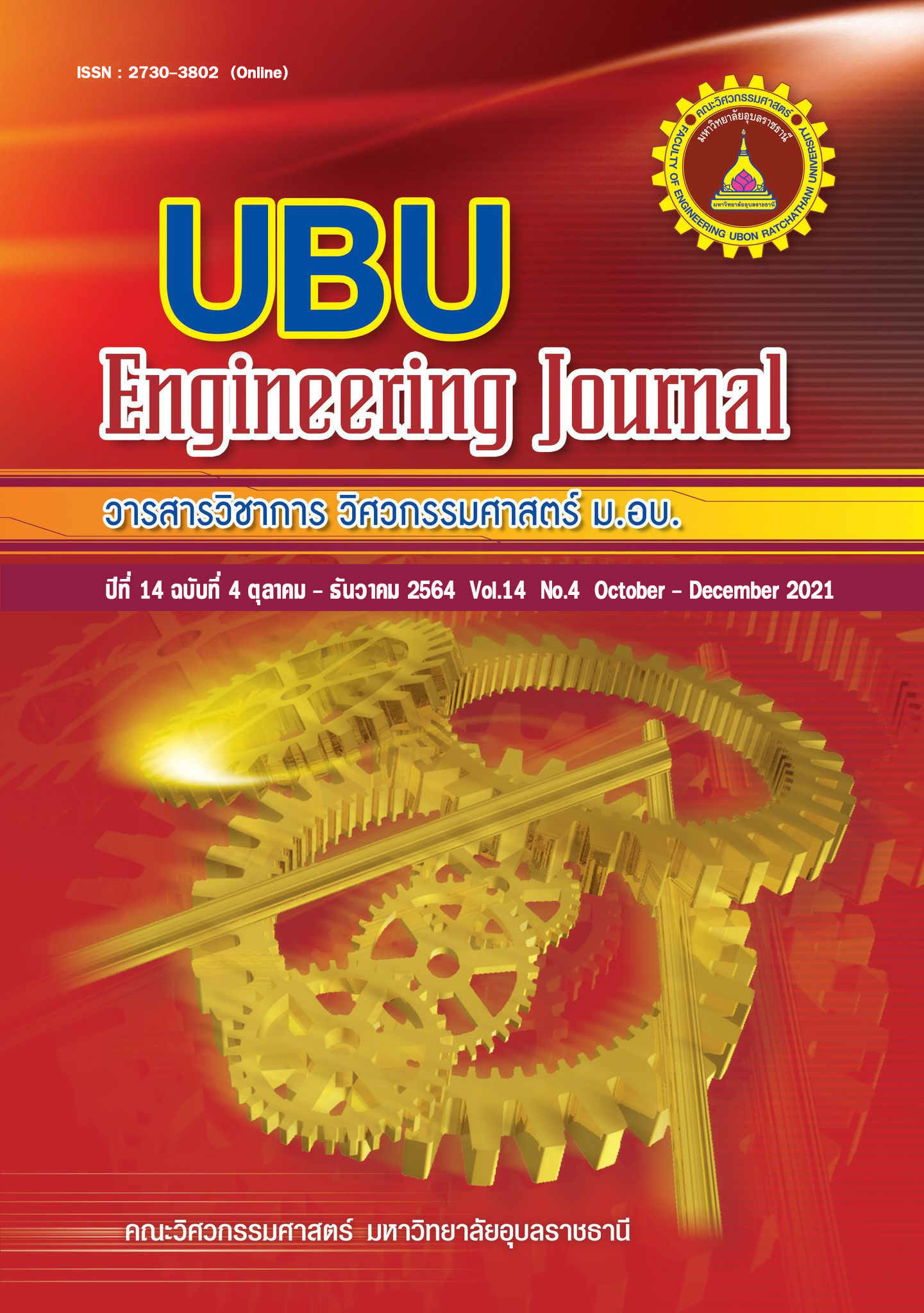Effect of Lignite Bottom Ash and Natural Rubber on Properties of Blended Cement Concrete
Main Article Content
Abstract
The aim of this research is to investigate the effect of Lignite bottom ash blended with natural rubber on mechanical properties of concrete. Mix design ratio of cement:sand:aggregate is used at 1:2:4 by volume. Lignite bottom ash was used to replace Portland cement of 0,10,15 and 20 percentage by weight. Water to cement ratio is 0.6. The natural-rubber ratio has been fixed at 7.5% by weight. To provide natural-rubber, the ammonia concentrate solution 15% concentration was added in to the natural-rubber at 3% by weight and in addition with 4 percent of nonionic surfactant is also used in the mixture. Mechanical properties i.e. workability, compressive strength and flexural strength were then tested. The results showed that the natural rubber is added, workability, compressive strength is decreased while flexural strength increased. A mixture of 10 percent of Lignite bottom ash could enhance the compressive strength in the long-term. The flexural in LBA10 was higher than concrete control 60 days, compressive strength of LBA10 was 99.97 percent of concrete control.
Article Details
References
[2] สำนักงานเศษฐกิจอุสาหกรรม, กระทรวงอุตสาหกรรม, สถิติอุตสาหกรรม : ซีเมนต์ ปี 2009 : http://www.oie.go.th/industry_stat/269410.html
[3] สำนักงานสนับสนุนการรวิจัย(สกว.), เรื่อง ประกาศรับข้อเสนิโครงการวิจัยยางพาราใหม่, 2548, http://www.trf.or.th
[4] สำนักงานกอนทุนสนับสนุนการวิจัย(สกว.), ประกาศรับโครงการวิจัยขนาเล็กเรื่องยางพารา, โครงการวิจัยแห่งชาติ:ฝ่ายยางพารา,2548, หน้า 7.
[5] เอกชัย พฤกษ์อำไพ, คู่มือยางพารา, เพ็ทแพล้น พัลลิชชิ่ง กรุงเทพฯ, 2547, หน้า 352
[6] ศุภโรจ พูลวณิชย์สกุล และคณะ, คุณสมบัติเชิงกลของคอนกรีตผสมมวลรวมเถ้าลอยลิกไนต์, วิศวกรรมสาร ฉบับที่2, 2542, หน้า 63-68.
[7] Electricity Generation Authority of Thailand (EGAT),Mae Moh Power Plant: Annual report on operations of ash and gypsum conveyor systems divition, Electricity Generation Department, 2016.
[8] Electricity Generation Authority of Thailand (EGAT), Criteria and conditions for selling bottom ash Mae Moh power plant, Byproduct Sales and Contract Management Divition, 2016.
[9] สิทธิชัย ศิริพันธุ์ และคณะ, โครงการการใช้ยางธรรมชาติเพื่อพัฒนางานคอนกรีต, สำนักงานกองทุนสนับสนุนการวิจัย, 2548.
[10] บุรฉัตร ฉัตรวีระ และ ณรงค์ดิ์ มากุล, ผลของเถ้าหนักจากถ่านหินลิกไนต์ที่มีต่อคุณสมบัติของซีเมนต์เพสต์, วิศวกรรสาร ฉบับวิจัยและพัฒนา, ปีที่12, ฉบับที่ 4, 2544.
[11] American Society for Testing and Materials, ASTM C 143-00 : Standart Test Method for Slump of Hydraulic-Cement Concrete, Annual Book of ASTM Standart, 2001, Vol.04.02,Philadephia, pp.89-91.
[12] American Society for Testing and Materials, ASTM C 39/C 39M-01 : Standart Test Method for Compressive Strength of Cylindrical Concrete Speciments, Annual Book of ASTM Standart, 2001, Vol.04.02,Philadephia, 18-22.
[13] American Society for Testing and Materials, ASTM C 78-00 : Standart Test Method for Flexural Strength of COmcrete (Using Simple Beam with Third-Point Loading), Annual Book of
ASTM Standart, 2001, Vol.04.02,Philadephia, 32-34.
[14] American Society for Testing and Materials, ASTM C168 : Standart Specifkcation for Coal Fly Ash and Raw of Calcined Natural Pozzolan for Use in Concrete, Annual Book of ASTM Standart, 200,Philadephia, USA.
[15] ปริญญา จินดาประเสริฐ และ ชัย จาตุรพิทักษ์กุล, ปูนซีเมนต์ ปอซโซลาน และคอนกรีต, สมาคมคอนกรีตไทย(ส.ค.ท.), สมาคมคอนกรีตไทย, 2547, 1, หน้า 44.
[16] ปริญญา จินดาประเสริฐ และ ชัย จาตุรพิทักษ์กุล, ปูนซีเมนต์ ปอซโซลาน และคอนกรีต, สมาคมคอนกรีตไทย(ส.ค.ท.), สมาคมคอนกรีตไทย, 2547, 1, หน้า 44.
[17] ประชุม คำพุฒ, การใช้น้ำยางข้นแบบแอมโมเนียปานกลางผสมในมอร์ต้าร์มวลเบา, วารสารวิชาการเทคโนโลยีอุตสาหกรรม, ปีที่4, ฉบับที่ 2, หน้า 49-56
[18] ประชุม คำพุฒ, การศึกษาการใช้น้ำยางพาราธรรมชาติผสมเพิ่มในคอนกรีตบล๊อก, วิศวกรรมสาร ฉบับวิจัยและพัฒนาปีที่18, ฉบับที่ 1, 2550

